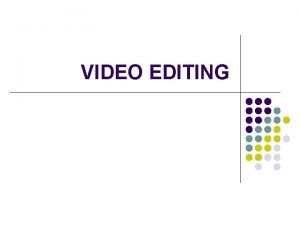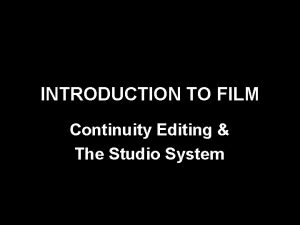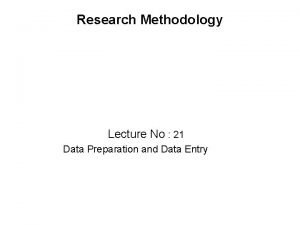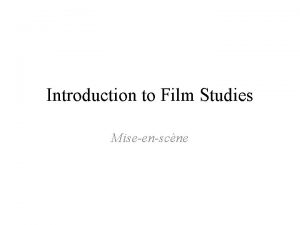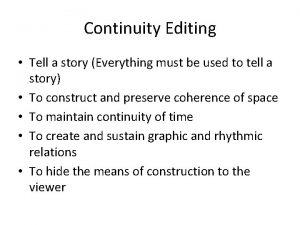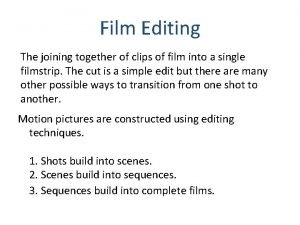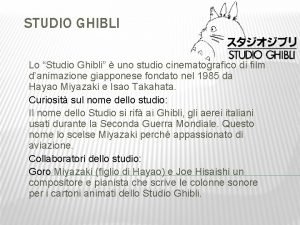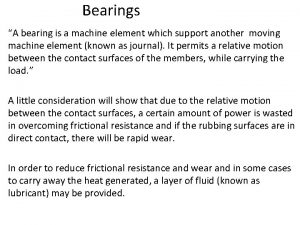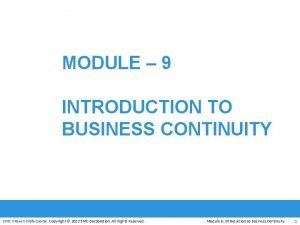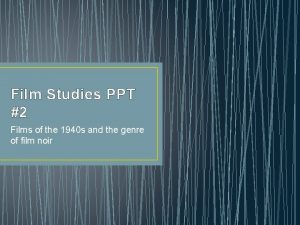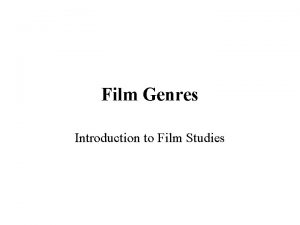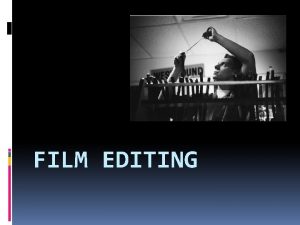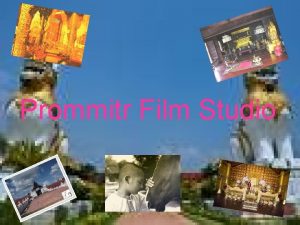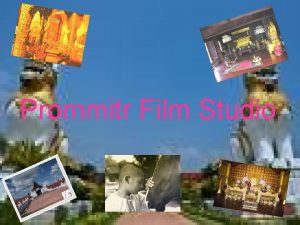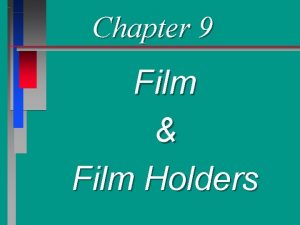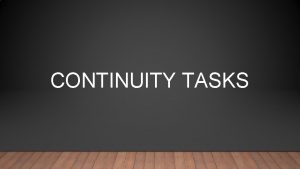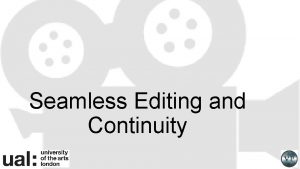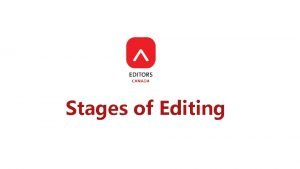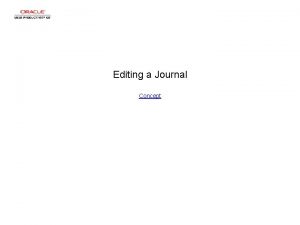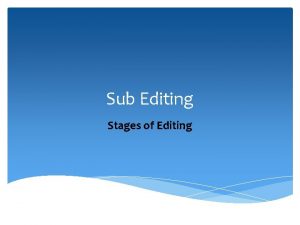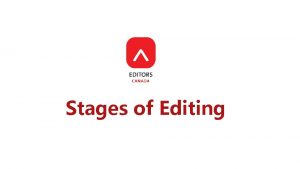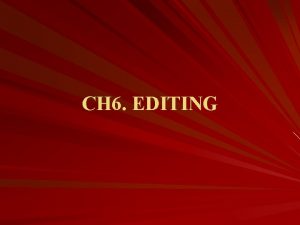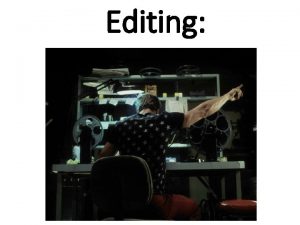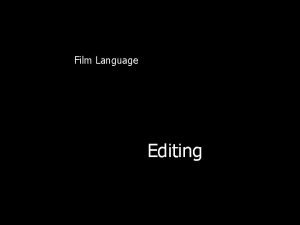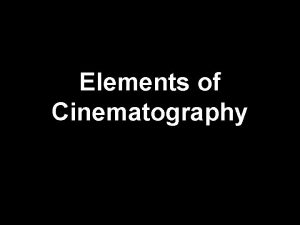INTRODUCTION TO FILM Continuity Editing The Studio System



































- Slides: 35

INTRODUCTION TO FILM Continuity Editing & The Studio System

Key Terms: Continuity editing – smooth seamless editing used to create narrative continuity. Shots are linked so that the cuts appear invisible to viewers. The style of Classical Hollywood cinema, and dominant language for narrative film. 180 -degree rule – a system of filming action that ensured continuity in the spatial relations between objects on screen. The camera must stay on one side of an imaginary 180 -degree line, or axis of action, that runs through the center of the set, from one side of the frame to the other. i. e. the camera does not cross the imaginary line, usually located behind the actors in the scene.

Establishing shot – a shot that establishes the whole space of a scene, commonly shown at the beginning of a scene. The establishing shot presents a more-or-less complete view of the scene, and is usually a long shot. Shot / reverse shot – the alternating shots of two characters in conversation, in conformity to the 180 -degree rule. In continuity editing, characters in one shot usually look left, in the other shot, right. Over-the-shoulder two shot – a shot containing two people viewed over the shoulder of one of them. A major component of Classical Hollywood style.


Match on action – a continuity cut that splices two shots of the same action together at the same moment of the movement, making the action appear to be continuous. Eyeline match – the alternation of a shot showing a character looking off screen with a shot of what they are looking at. Sequence - a unit of film structure made up of one or more scenes or shots that combine to form a larger unit. Shot / Scene / Sequence

Analysis:

Analysis: 1. Formal Language: what kinds of shots, editing, structure

Analysis: 1. Formal Language: what kinds of shots, editing, structure 2. Meaning: how does the filmic language construct the narrative? Who are the (main) characters and what happens to them in this scene? (Referential and explicit meanings)

Dance, Girl, Dance (1940) Dir. Dorothy Arzner

Dorothy Arzner • 1897 -1979 • From 1927 till her retirement in 1943, Arzner was the only female director working in the Hollywood studio system. • Starting as a film editor, she made 20 films during her career.

Analysis: 1. Formal Language: what kinds of shots, editing, structure 2. Meaning: how does the filmic language construct the narrative? Who are the (main) characters and what happens to them in this scene? (Referential and explicit meanings) 3. Identify other meanings: implicit, symptomatic

Analysis: 4. How does this film exemplify Classical Hollywood style? What does it tell us about this style?

Other Conventions and Characteristics of Hollywood Studio Films: • 90 -degree rule: scenes are typically photographed off the 90 -degree angle to create the illusion of depth. Straight-on 90 degree shots are unusual. • Suturing effect – a process in which the viewer’s gaze is stitched into the narrative. “We become part of the telling of the story as well as the one to whom the story is told. ” (Kolker, p. 88)

• Conventions as “established common traits. ” (Film Art, p. 52) “obviousness” (Kolker, p. 96) They are ideological. • Continuity editing - economically driven, industry standard for Classical Hollywood style for both production and reception • Gender and coding: conventions are learnt, consciously or subconsciously, and can be played with, challenged, shifted.

Continuity editing is the dominant style, but not the only style:

Continuity editing is the dominant style, but not the only style: • Ellipsis and montage (editing) used to condense and expand time

Continuity editing is the dominant style, but not the only style: • Ellipsis and montage (editing) used to condense and expand time • Jump cuts: disruption (e. g. Jean-Luc Goddard, Andy Warhol)

Continuity editing is the dominant style, but not the only style: • Ellipsis and montage (editing) used to condense and expand time • Jump cuts: disruption (e. g. Jean-Luc Goddard, Andy Warhol) • 360 -degree space (used be Jacques Tati, Yasujiru Ozu, and others outside of Hollywood)

Continuity editing is the dominant style, but not the only style: • Ellipsis and montage (editing) used to condense and expand time • Jump cuts: disruption (e. g. Jean-Luc Goddard, Andy Warhol) • 360 -degree space (used be Jacques Tati, Yasujiru Ozu, and others outside of Hollywood) • Non-diegetic inserts – symbolic or metaphorical images outside of the diegesis.

Continuity editing is the dominant style, but not the only style: • Ellipsis and montage (editing) used to condense and expand time • Jump cuts: disruption (e. g. Jean-Luc Goddard, Andy Warhol) • 360 -degree space (used be Jacques Tati, Yasujiru Ozu, and others outside of Hollywood) • Non-diegetic inserts – symbolic or metaphorical images outside of the diegesis. • Resistance to synchronized sound (e. g. Rene Clair and Soviet filmmakers)

The Studio Era in Hollywood 1930 s-40 s • The rise of the U. S. film industry from Production of Now, Voyager (1942) Dir. Irving Rapper, Warner Bros. the late 19 th century to the 1930 s, marked by trade associations MPAA and MPA (Motion Picture Association) founded in 1922 and still exist today.

• The Big Five: Paramount, Loew’s/MGM, Fox Films, Warner Brothers, RKO • All had their own pre and post. MGM Studio Orchestra, 1951 production, distribution, and exhibition venues. (Vertical integration) • The Little Three: Universal Pictures, Columbia Pictures, and United Artists

• “Poverty Row”: companies including Monogram and Republic Pictures produce “Bmovies” in a double feature Paramount Studio, 1933 • Influence of the Production Code (Hays Code): self-censorship • Genres of the studio era: musicals, gangster, newspaper picture, biopic, screwball comedies, mystery/horror/noir (later in the ‘ 40 s)

• Decline of the studio era: Paramount antitrust decrees (1948), rise of independent productions in the 1950 s, emergence of TV, suburbanization • The 1970 s: New Hollywood Production of Raffles (1930) Dir. George Fitzmaurice Samuel Goldwyn Company • Today - multi-national media conglomerates (News Corps, Time Warner, Walt Disney Co. , Comcast)

Analyses of Classical Hollywood Cinema:

Analyses of Classical Hollywood Cinema: • Acting and performance

Analyses of Classical Hollywood Cinema: • Acting and performance • Film music

Analyses of Classical Hollywood Cinema: • Acting and performance • Film music • Textual analysis (“reading a film”) linguistics, semiotics, Marxism, psychoanalysis

Analyses of Classical Hollywood Cinema: • Acting and performance • Film music • Textual analysis (“reading a film”) linguistics, semiotics, Marxism, psychoanalysis • Reception studies

Analyses of Classical Hollywood Cinema: • Acting and performance • Film music • Textual analysis (“reading a film”) linguistics, semiotics, Marxism, psychoanalysis • Reception studies • Feminist film theory (psychoanalysis, spectatorship)

Analyses of Classical Hollywood Cinema: • Acting and performance • Film music • Textual analysis (“reading a film”) linguistics, semiotics, Marxism, psychoanalysis • Reception studies • Feminist film theory (psychoanalysis, spectatorship) • Queering

Some questions to consider in classical film analysis:

Some questions to consider in classical film analysis: 1. What is the smoothness, unobtrusiveness, invisibility/inaudibility of continuity style hiding in Classical Hollywood films?

Some questions to consider in classical film analysis: 2. How are particular films put together? And what effects and functions particular films have?

Some questions to consider in classical film analysis: 3. What will count as an “appropriate” reading of a given film and to what extent will the contingencies of the extra-textual determine the form of interpretative processing to which a particular film is subject?
 Continuity editing
Continuity editing Continuity editing definition
Continuity editing definition Field editing and central editing in research
Field editing and central editing in research Linear and nonlinear editing
Linear and nonlinear editing Re-establishing shot
Re-establishing shot Story continuity
Story continuity Absolute continuity implies uniform continuity
Absolute continuity implies uniform continuity This was joined by film editing
This was joined by film editing Xna visual studio 2017
Xna visual studio 2017 Xbox xna
Xbox xna Uno studio ghibli
Uno studio ghibli Wedge film journal bearing
Wedge film journal bearing Emc
Emc Film genres ppt
Film genres ppt Film genres and subgenres
Film genres and subgenres Hát kết hợp bộ gõ cơ thể
Hát kết hợp bộ gõ cơ thể Lp html
Lp html Bổ thể
Bổ thể Tỉ lệ cơ thể trẻ em
Tỉ lệ cơ thể trẻ em Chó sói
Chó sói Tư thế worms-breton
Tư thế worms-breton Bài hát chúa yêu trần thế alleluia
Bài hát chúa yêu trần thế alleluia Môn thể thao bắt đầu bằng chữ f
Môn thể thao bắt đầu bằng chữ f Thế nào là hệ số cao nhất
Thế nào là hệ số cao nhất Các châu lục và đại dương trên thế giới
Các châu lục và đại dương trên thế giới Công thức tính thế năng
Công thức tính thế năng Trời xanh đây là của chúng ta thể thơ
Trời xanh đây là của chúng ta thể thơ Cách giải mật thư tọa độ
Cách giải mật thư tọa độ 101012 bằng
101012 bằng độ dài liên kết
độ dài liên kết Các châu lục và đại dương trên thế giới
Các châu lục và đại dương trên thế giới Thơ thất ngôn tứ tuyệt đường luật
Thơ thất ngôn tứ tuyệt đường luật Quá trình desamine hóa có thể tạo ra
Quá trình desamine hóa có thể tạo ra Một số thể thơ truyền thống
Một số thể thơ truyền thống Cái miệng xinh xinh thế chỉ nói điều hay thôi
Cái miệng xinh xinh thế chỉ nói điều hay thôi Vẽ hình chiếu vuông góc của vật thể sau
Vẽ hình chiếu vuông góc của vật thể sau
